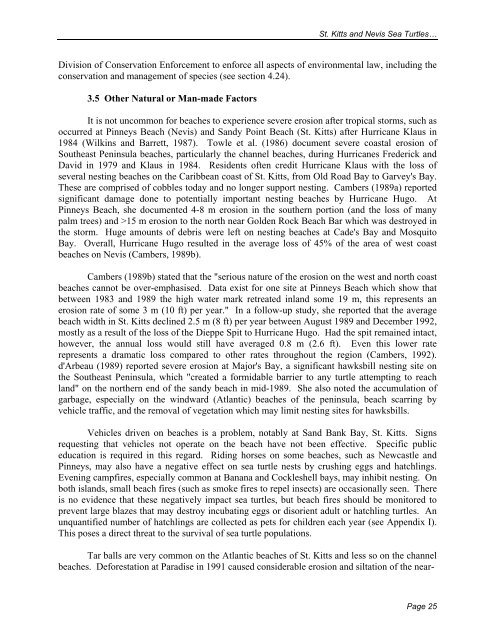Sea Turtle Recovery Action Plan for St. Kitts and Nevis - WIDECAST
Sea Turtle Recovery Action Plan for St. Kitts and Nevis - WIDECAST
Sea Turtle Recovery Action Plan for St. Kitts and Nevis - WIDECAST
You also want an ePaper? Increase the reach of your titles
YUMPU automatically turns print PDFs into web optimized ePapers that Google loves.
<strong>St</strong>. <strong>Kitts</strong> <strong>and</strong> <strong>Nevis</strong> <strong>Sea</strong> <strong>Turtle</strong>s…<br />
Division of Conservation En<strong>for</strong>cement to en<strong>for</strong>ce all aspects of environmental law, including the<br />
conservation <strong>and</strong> management of species (see section 4.24).<br />
3.5 Other Natural or Man-made Factors<br />
It is not uncommon <strong>for</strong> beaches to experience severe erosion after tropical storms, such as<br />
occurred at Pinneys Beach (<strong>Nevis</strong>) <strong>and</strong> S<strong>and</strong>y Point Beach (<strong>St</strong>. <strong>Kitts</strong>) after Hurricane Klaus in<br />
1984 (Wilkins <strong>and</strong> Barrett, 1987). Towle et al. (1986) document severe coastal erosion of<br />
Southeast Peninsula beaches, particularly the channel beaches, during Hurricanes Frederick <strong>and</strong><br />
David in 1979 <strong>and</strong> Klaus in 1984. Residents often credit Hurricane Klaus with the loss of<br />
several nesting beaches on the Caribbean coast of <strong>St</strong>. <strong>Kitts</strong>, from Old Road Bay to Garvey's Bay.<br />
These are comprised of cobbles today <strong>and</strong> no longer support nesting. Cambers (1989a) reported<br />
significant damage done to potentially important nesting beaches by Hurricane Hugo. At<br />
Pinneys Beach, she documented 4-8 m erosion in the southern portion (<strong>and</strong> the loss of many<br />
palm trees) <strong>and</strong> >15 m erosion to the north near Golden Rock Beach Bar which was destroyed in<br />
the storm. Huge amounts of debris were left on nesting beaches at Cade's Bay <strong>and</strong> Mosquito<br />
Bay. Overall, Hurricane Hugo resulted in the average loss of 45% of the area of west coast<br />
beaches on <strong>Nevis</strong> (Cambers, 1989b).<br />
Cambers (1989b) stated that the "serious nature of the erosion on the west <strong>and</strong> north coast<br />
beaches cannot be over-emphasised. Data exist <strong>for</strong> one site at Pinneys Beach which show that<br />
between 1983 <strong>and</strong> 1989 the high water mark retreated inl<strong>and</strong> some 19 m, this represents an<br />
erosion rate of some 3 m (10 ft) per year." In a follow-up study, she reported that the average<br />
beach width in <strong>St</strong>. <strong>Kitts</strong> declined 2.5 m (8 ft) per year between August 1989 <strong>and</strong> December 1992,<br />
mostly as a result of the loss of the Dieppe Spit to Hurricane Hugo. Had the spit remained intact,<br />
however, the annual loss would still have averaged 0.8 m (2.6 ft). Even this lower rate<br />
represents a dramatic loss compared to other rates throughout the region (Cambers, 1992).<br />
d'Arbeau (1989) reported severe erosion at Major's Bay, a significant hawksbill nesting site on<br />
the Southeast Peninsula, which "created a <strong>for</strong>midable barrier to any turtle attempting to reach<br />
l<strong>and</strong>" on the northern end of the s<strong>and</strong>y beach in mid-1989. She also noted the accumulation of<br />
garbage, especially on the windward (Atlantic) beaches of the peninsula, beach scarring by<br />
vehicle traffic, <strong>and</strong> the removal of vegetation which may limit nesting sites <strong>for</strong> hawksbills.<br />
Vehicles driven on beaches is a problem, notably at S<strong>and</strong> Bank Bay, <strong>St</strong>. <strong>Kitts</strong>. Signs<br />
requesting that vehicles not operate on the beach have not been effective. Specific public<br />
education is required in this regard. Riding horses on some beaches, such as Newcastle <strong>and</strong><br />
Pinneys, may also have a negative effect on sea turtle nests by crushing eggs <strong>and</strong> hatchlings.<br />
Evening campfires, especially common at Banana <strong>and</strong> Cockleshell bays, may inhibit nesting. On<br />
both isl<strong>and</strong>s, small beach fires (such as smoke fires to repel insects) are occasionally seen. There<br />
is no evidence that these negatively impact sea turtles, but beach fires should be monitored to<br />
prevent large blazes that may destroy incubating eggs or disorient adult or hatchling turtles. An<br />
unquantified number of hatchlings are collected as pets <strong>for</strong> children each year (see Appendix I).<br />
This poses a direct threat to the survival of sea turtle populations.<br />
Tar balls are very common on the Atlantic beaches of <strong>St</strong>. <strong>Kitts</strong> <strong>and</strong> less so on the channel<br />
beaches. De<strong>for</strong>estation at Paradise in 1991 caused considerable erosion <strong>and</strong> siltation of the near-<br />
Page 25
















